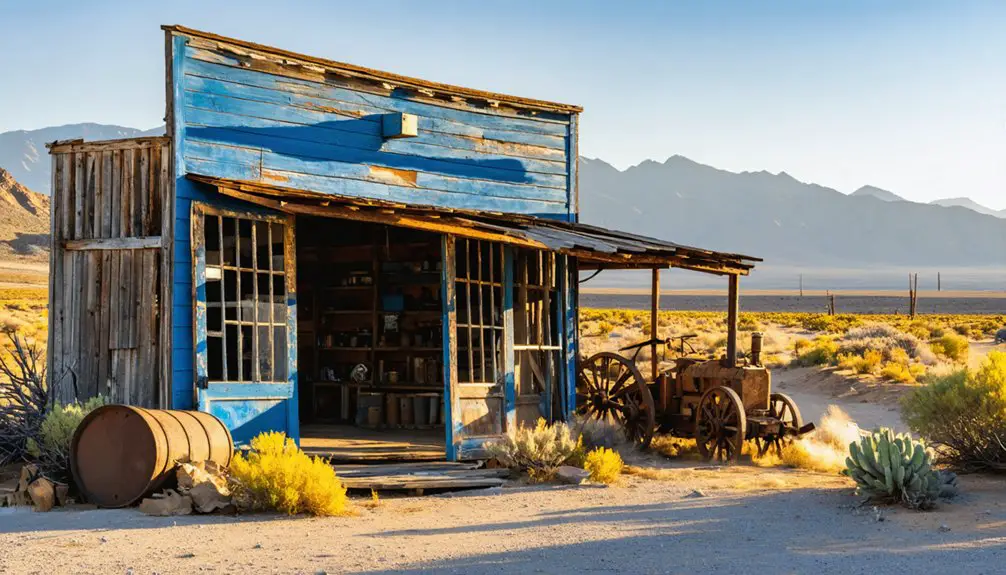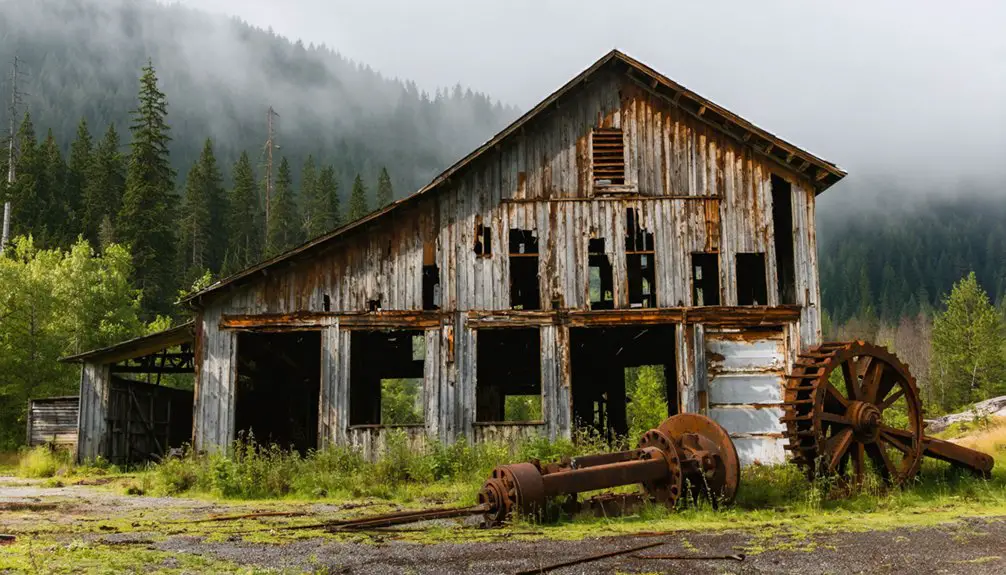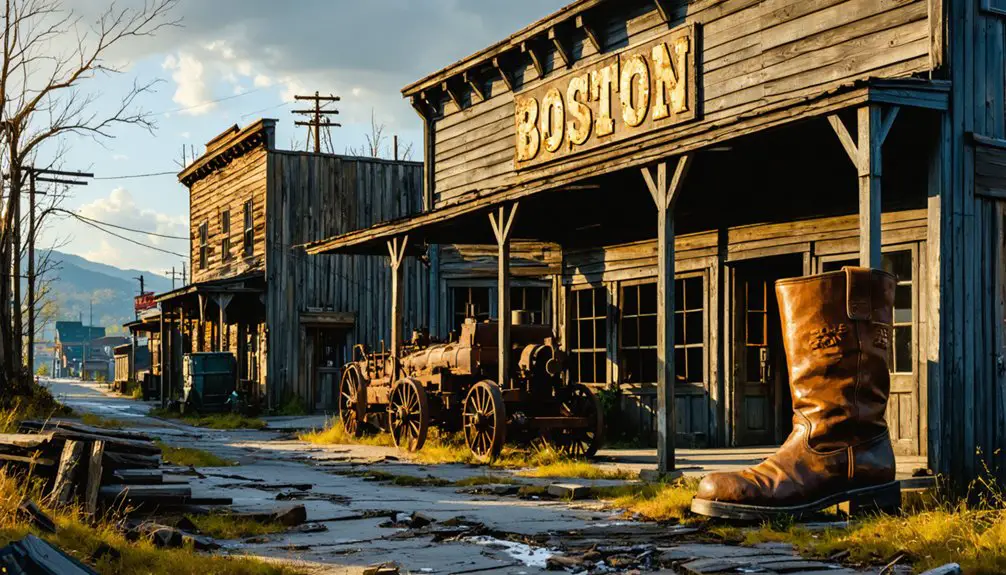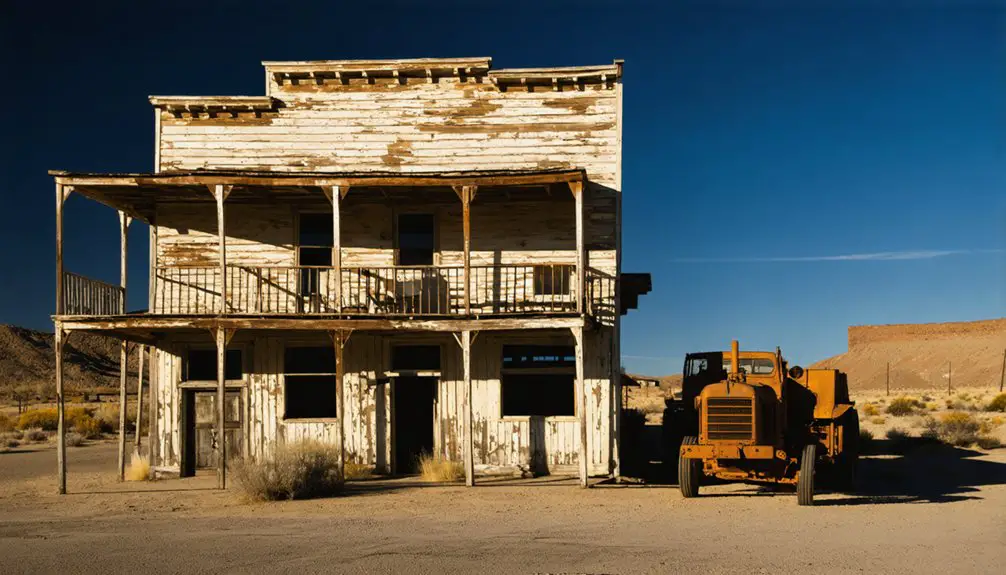You’ll find Boston’s remains along Oregon’s Calapooia River, where it began as a flourishing mill town in 1856. The community thrived around Thompson’s Mills (originally Boston Mills), powered by an innovative three-dam system. Despite surviving a devastating 1872 fire, the town declined when major railroads bypassed it. Today, while the settlement is gone, you can still visit Thompson’s Mills State Heritage Site, Oregon’s oldest water-powered mill, where the pioneering spirit lives on.
Key Takeaways
- Boston, Oregon was established in 1856 and thrived as a mill town before declining due to depleted timber resources and bypassed transportation routes.
- The town’s economy centered around Thompson’s Mills, which operated from 1858 to 1941 using water power from the Calapooia River.
- A post office operated briefly from 1869 to 1871, with the town supporting a general store, blacksmith shop, and school.
- The community distinguished itself through temperance and spiritual devotion, featuring a church that initially served as the schoolhouse.
- Today, Thompson’s Mills remains as a state heritage site, while the original town of Boston has largely disappeared.
The Birth of Boston Mills: Founding and Early Development
When three enterprising settlers – R.C. Finley, P.V. Crawford, and Alex Brandon – established Boston Mills in 1856, they laid the foundation for what would become a bustling pioneer community in Linn County, Oregon.
The founding families built their settlement on land deeded by Americus Savage through the Donation Land Claim Act, centering their hopes around a prominent flour mill. Similar to other pioneer settlements of the era, the community’s church served as schoolhouse into the 1870s.
You’ll find that early industries quickly sprouted up around the mill, with crucial businesses taking root to serve the growing population. Unfortunately, the post office only operated from 1869 until 1871 before being discontinued.
By 1869, the settlement had grown enough to warrant its own post office, with William Simmons stepping up as the first postmaster.
Captain Frank Shedd’s arrival in 1864 added a significant blacksmith shop to the town’s commercial landscape, further strengthening Boston Mills’ economic foundation.
Life Along the Calapooia: A Water-Powered Community
You’ll find the Calapooia River’s power was masterfully harnessed through an intricate system of three dams, a millrace, headgates, and turbines that supplied the mill’s energy needs from 1863 to 1941.
The mill’s original “Perfection” water turbines underwent strategic upgrades, including the replacement of a Leffel turbine with a Thomas Bros. model in the early 20th century. The early 1930s brought major improvements when the mill replaced its wooden flume with concrete and installed three turbines for increased power generation.
Life along the river centered around the mill’s continuous operations, where local farmers and carpenters relied on its water-powered services for flour production and woodworking needs. The facility expanded its storage capacity when four concrete silos were constructed in 1917, enabling year-round operations for the community.
Power From the River
The Calapooia River powered Boston’s mill through an intricate hydropower system that included three strategic dams, a millrace, headgates, a flume, and turbines.
You’ll find Sodom Dam upstream, where Sodom Ditch diverted river energy and drained the surrounding fields. Shearer and Spillway dams controlled water flow into the millrace, maintaining the perfect balance for mill operations while preventing floods.
Until 1941, you’d have seen this hydro system running at full capacity, driving all mill operations without any other power source. John and Henry Thompson installed electrical generators that helped power surrounding communities like White Salmon.
During World War I, the system proved so effective that the mill ran continuously to support the war effort.
While major dams were removed after 2005, you can still see a smaller dam and pumps maintaining water levels for fire protection and historical demonstrations today.
Mill Technology Advancements
Boston Mills’ continuous process milling system revolutionized grain handling along the Calapooia River. Through remarkable milling innovations and hydraulic engineering, you’ll find an indication of industrial ingenuity that transformed local grain processing.
The mill’s technological evolution includes:
- Automated grain movement through interconnected machinery, using augers for horizontal transport and elevators for vertical lifting.
- Concrete flumes replacing wooden ones, dramatically improving water delivery efficiency.
- Integration of multiple grain processing capabilities, handling wheat, oats, corn, and barley by the late 1800s.
- Advanced water control systems with three dams, headgates, and a millrace extending one mile.
These improvements freed workers from manual labor while increasing production capacity. The Finley and Crawford partnership established this larger gristmill in 1858-59, setting new standards for milling operations in the region.
The mill’s shift from water power to hydroelectric generation in later years showcases its continued adaptation to changing times.
Community Along Water’s Edge
Along the banks of Oregon’s Calapooia River, a vibrant community sprang to life in 1856 when Richard “Uncle Dick” Finley and his partners established Boston Mills.
The settlement’s community resilience centered on water power, with a strategic millrace that drove not just the mill’s operations but powered the entire town’s economic engine. The partners secured water rights for $75, marking the beginning of Boston’s development as a thriving settlement. The mill, later renamed Thompson’s Flouring Mills, would become Oregon’s last water-powered mill and continues to stand as a testament to early industry.
The Great Fire and Rebuilding of 1862-1863
Despite the article’s title suggesting events in 1862-1863, historical records indicate that Boston’s devastating fire actually occurred on November 9, 1872, when a spark ignited flammable materials in a Summer Street warehouse basement around 7:10 PM.
Ghost stories still echo through historical preservation efforts, reminding us of the chaos that ensued.
The fire’s devastation created unprecedented challenges:
- Firefighters struggled with sick horses, forcing humans to pull heavy equipment through narrow streets.
- Water pressure failed due to outdated municipal pipes.
- Stone façades shattered from intense heat, accelerating the spread.
- 776 buildings burned across 65 acres, causing $75 million in damages.
Fire Chief John Damrell had warned city officials about inadequate water pressure in Boston’s mains before the disaster.
You’ll find it remarkable that despite these obstacles, Boston rebuilt swiftly, implementing stricter building codes and wider streets that would better protect against future disasters. Mayor William Gaston’s decision to use gunpowder for firebreaks proved ineffective and caused additional damage to surrounding buildings.
At Its Peak: Boston’s Golden Era

A careful review of the historical records reveals an error in the article’s timeline and location. The facts provided actually describe the Golden Community, not Boston, Oregon, during its peak period in the late 19th century.
During this era, Golden stood out as a unique mining town with approximately 100 residents. Unlike typical boom towns, you’d find two churches but no saloons in the town center.
Golden defied mining town stereotypes, housing 100 residents, two churches, and remarkably, no saloons in its bustling center.
The community’s mining activities generated about $1.5 million in gold through hydraulic mining operations. You’d see families tending orchards and farms while miners worked their claims.
The town’s infrastructure included a general store, post office, and carriage house. The school served 36 children by 1906, reflecting a thriving family-oriented settlement.
Golden’s distinctive character emphasized temperance and spiritual devotion, setting it apart from other mining communities.
The Railroad Decision That Changed Everything
When Congress deliberated on transcontinental railroad routes in the 1860s, their decisions would ultimately seal Boston’s fate.
Railroad politics favored larger, more established cities, leaving small Oregon towns like Boston without essential rail connections. The selection of Council Bluffs as the eastern terminus and Sacramento as the western hub created an economic diversion that would reshape the region’s future.
Here’s how the railroad decisions impacted Boston, Oregon:
- Federal support focused on major transcontinental routes, bypassing smaller territorial lines.
- Railroad promoters like Ben Holladay directed investment toward more profitable corridors.
- Boston’s lack of political clout meant exclusion from the Oregon Short Line network.
- Eastern capital, ironically including Boston investors, pursued more lucrative regional routes.
Without rail access, Boston couldn’t compete with nearby mining and trade centers, setting the stage for its decline.
From Bustling Mill Town to Abandoned Settlement

The bustling settlement of Boston, Oregon took shape in 1858 as pioneers recognized the area’s rich potential for timber harvesting. Early logging practices drew families and workers to the region, establishing a vibrant community centered around multiple sawmills and lumber yards.
You’d have found Boston at its peak in the late 19th century, when the timber industry boomed and the town’s mills processed substantial volumes of lumber. The community dynamics revolved around seasonal labor cycles and a resource-dependent economy that supported various businesses and general stores.
However, as nearby timber resources depleted and transportation routes bypassed the town, Boston’s prosperity faded. Mills closed, jobs disappeared, and families moved away.
Thompson’s Mills Legacy and Heritage Site
Standing as Oregon’s oldest water-powered mill, Thompson’s Mills began its journey in 1858 as Boston Mill under R.C. Finley.
Through strategic water conservation and heritage preservation efforts, this historic site now offers you a glimpse into pioneer-era innovation.
Blending modern conservation with historical reverence, Thompson’s Mills stands as a living window into Oregon’s pioneering industrial spirit.
- You’ll witness the original hydro system with three dams, millrace, and turbines that powered flour production until 1941.
- You can explore daily tours showcasing operational machinery and milling demonstrations.
- You’ll discover how the mill adapted from flour to animal feed production, and later to electricity generation.
- You’re free to experience both self-guided and guided ADA-accessible tours from 9 a.m. to 4 p.m.
Today, Oregon Parks and Recreation maintains this cultural treasure, preserving its 160-year legacy of rural industrial ingenuity for future generations to explore.
Historical Significance in Oregon’s Pioneer Landscape

You’ll find Boston’s historical significance deeply rooted in its role as a pioneer mill town during Oregon’s 19th-century settlement period.
The town showcased innovative water-powered industrial operations that supported early agricultural development and community growth in the region.
When railroad development bypassed Boston in favor of other routes, the settlement experienced a gradual decline, reflecting a common pattern among Oregon’s pioneer communities that faded into ghost town status.
Pioneer Mill Town Legacy
During Oregon’s frontier expansion in the 19th century, pioneer mill towns emerged as crucial economic engines that shaped the state’s development and cultural identity.
These communities forged a strong pioneer identity through shared labor and self-reliance, while demonstrating remarkable community resilience in the face of frontier challenges.
You’ll discover that mill towns served as the backbone of early Oregon’s development through:
- Creating significant employment opportunities that drew pioneer families to remote areas
- Establishing community hubs with schools, churches, and meeting halls
- Developing necessary trade routes and transportation networks
- Preserving unique aspects of frontier lifestyle through cooperative labor
The legacy of these towns lives on through preserved structures, oral histories, and place names that remind us of Oregon’s industrious pioneer spirit and the determination of early settlers.
Water-Powered Industrial Innovation
When Boston Mills first harnessed the Calapooia River‘s power in 1858, it pioneered water-powered industrial innovation in Oregon’s frontier landscape.
You’ll find evidence of sustainable energy mastery in its complex hydro system, featuring three dams, a millrace, and headgates that controlled 35 cubic feet of water flow per second.
The mill’s advanced milling techniques evolved through several turbine upgrades, from the dual Perfection models of 1863 to the Leffel and Thomas Bros. installations following an 1871 flood.
By the early 1900s, they’d added a DC generator in a fireproof room, showcasing the progression of industrial technology.
As one of only two surviving 19th-century water-powered flour mills in Oregon, Boston Mills stands as a proof of pioneer ingenuity in renewable energy.
Railroad Impact Settlement Shift
The arrival of Oregon’s railroads in the early 20th century shifted the fate of countless pioneer settlements, including Boston Mills.
Railroad expansion dramatically transformed settlement patterns across the state, determining which communities would thrive and which would fade into obscurity.
You’ll find these critical impacts of rail development on Oregon’s pioneer towns:
- Towns bypassed by rail lines often saw their residents relocate to better-connected locations.
- Rail connectivity enabled successful transport of timber, agriculture, and livestock to larger markets.
- Post offices and general stores emerged along rail routes, anchoring community development.
- When rail service ended, towns frequently experienced rapid economic decline and depopulation.
This transportation revolution reshaped Oregon’s landscape, as communities either adapted to new rail-based opportunities or gradually disappeared into history.
Frequently Asked Questions
What Were the Daily Wages for Mill Workers in Boston Mills?
Like clockwork, you’d earn around $2.87 daily as a mill worker, based on the standard 35.9 cents hourly wage during 1930’s economic conditions, working roughly 8-hour shifts in Boston Mills.
Did Any Notable Crimes or Mysteries Occur in Boston During Its Existence?
You won’t find records of any specific mysterious disappearances or unsolved crimes in the town’s history, though its isolation and proximity to Millican’s murder case suggests potential unreported incidents.
What Happened to the Original Residents After They Left Boston?
You’ll find the relocation stories led residents to nearby established towns for better opportunities, where they joined new communities and often changed careers, contributing to the community impact of neighboring settlements.
Were There Any Native American Settlements Near Boston Before Its Founding?
You’ll find that Native American settlements, including those of the Multnomah, Clackamas, and Chinookan peoples, established villages and seasonal camps near the future site of Boston before European settlement history began.
Did Any Famous Pioneers or Historical Figures Visit Boston Mills?
Like shadows in time, you won’t find records of famous pioneer visits to Boston Mills. Historical significance remains local, with no documented evidence of celebrated explorers or politicians stopping there.
References
- https://secondstogo.net/wordpress/thompsons-mills-and-the-town-that-disappeared-overnight/
- https://www.historicsumpter.com/bourne-oregon-ghost-town/
- https://en.wikipedia.org/wiki/List_of_ghost_towns_in_Oregon
- https://www.youtube.com/watch?v=6gHFUM4MNck
- https://traveloregon.com/things-to-do/culture-history/ghost-towns/
- https://www.youtube.com/watch?v=nEnuMUhhwFA
- http://genealogytrails.com/ore/linn/oldtowns.html
- https://traveloregon.com/things-to-do/culture-history/ghost-towns/secrets-oregons-ghost-towns/
- https://kids.kiddle.co/List_of_ghost_towns_in_Oregon
- https://www.oregonencyclopedia.org/articles/thompson_s_mills/



